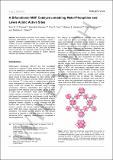Polyimide-cellulose interaction in Sb anode enables fast charging lithium-ion battery application
Abstract
Antimony-based electrodes are promising as fast charging anodes for lithium-ion batteries because their operating potential is about 0.8 V vs. Li/Li+, far away from the plating potential of Li. However, their capacity decays fast due to large volume expansion, the issue which has often been addressed through the use of nano-sized materials. Herein, we utilize an ion-dipole interaction between polyimide and carboxymethyl cellulose which suppresses particle cracking and holds the particle together to enable antimony anodes utilizing micron-sized Sb particles for high rate applications. Sb anode with 9.4% polyimide coating exhibits a high reversible capacity of 580 mAh g−1 at 1 A g−1 with excellent cycle performance. The rate performance of the electrode can be further improved by adding 5% acetylene black during the polyimide coating process. Even at a current rate of 20 C (13.2 A g−1), a highly reversible capacity of 380 mAh g−1 can be obtained. The superior high-rate capability and excellent stability of Sb anodes are further verified by full-cell tests with LiFePO4 cathodes.
Citation
Wang , S , Lee , P-K , Yang , X , Rogach , A L , Armstrong , A R & Yu , D Y W 2018 , ' Polyimide-cellulose interaction in Sb anode enables fast charging lithium-ion battery application ' , Materials Today Energy , vol. 9 , pp. 295-302 . https://doi.org/10.1016/j.mtener.2018.06.007
Publication
Materials Today Energy
Status
Peer reviewed
ISSN
2468-6069Type
Journal article
Description
The work described in this paper was supported by a General Research Fund (CityU 21202014) and the SFC/RGC Joint Research Scheme (X-CityU102/14) from the Research Grants Council of the Hong Kong Special Administrative Region, China and 2014_HK-Scot-0072 from the Scottish Funding Council.Collections
Items in the St Andrews Research Repository are protected by copyright, with all rights reserved, unless otherwise indicated.

